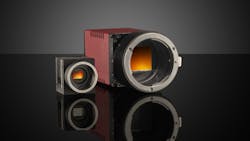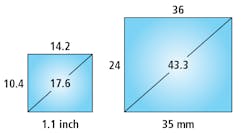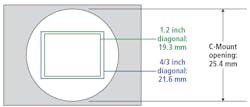Next generation image sensors: Are suppliers ready to meet growing customer expectations?
During the last decade, image sensor manufacturers have driven increases in resolution and performance, dramatically changing the face of industrial imaging, machine vision, and factory automation. These companies have also helped create a path for new markets such as vision-guided robotics and all things autonomous.
Image sensors with increased pixel counts have regularly come to market, replacing their lower-performing counterparts. Shrinking pixel sizes has also kept sensor footprints reasonably small, allowing for the continued utilization of the C-Mount as a part of most machine vision camera designs. This process of increasing pixel count and shrinking size repeated itself every few years, benefiting customers and suppliers alike.
Faced with a limitation of how small of a pixel can be effectively utilized with traditional optics, it was inevitable that as pixel counts continued to increase, image sensors would eventually grow to sizes that would require additional mounting options beyond the C-Mount (Figure 1). Beyond simply changing the types of standard mounts used by camera manufacturers, there are several issues that component suppliers and consumers need to consider to successfully support the next round of image sensor deployment on the horizon. One of these key issues is the availability of proper optics.
Customer expectations
By and large, customers want to maximize the performance of a camera with optics that have commensurate performance, but expectations for the optics go beyond imaging per formance alone. Cost-effective lenses in the smallest package size possible is typically desired. Up until recently, the largest individual dimension of image sensors available for factory automation and machine vision applications have primarily been either 17.6 mm or smaller, known as a 1.1-inch sensor format, or 43.3 mm or greater, known as a full-frame sensor format (Figure 2).
This huge gap in size is associated with the availability of lens products from other industries, such as closed-circuit television (CCTV) for the smaller image sensors and photography and enlarger lenses for the larger image sensor sizes. As a result, the machine vision community has utilized the C-Mount and photographic mounts for decades when building industrial cameras.
The next round of upcoming image sensor resolution increases requires the deployment of the 1.2 inch, 4/3 inch, APS-C, and APS-H image sensor formats into the machine vision and factory automation space. There will now be a continuum of sensor sizes in between the formerly limited selection of standard small and large sensors (Figure 3). The easiest thing to do would be placing these intermediate-size image sensors in the larger, currently-available photographic mounts and moving forward, but this can inherently be in conflict with customers’ expectations around performance, size, and cost effectiveness.
Optical performance and customer expectations
On paper, it makes sense to design a line of lenses that work well with all the intermediate size image sensors as well as their full-frame siblings. However, this leads to products that can be oversized, more expensive than necessary, and, strangely enough, underperforming. This sub-optimal performance can typically be seen in lenses that have a focal length to sensor size ratio of less than 1 to 1.5.
For example, a lens designed for a full-frame sensor with a 50 mm focal length has a focal length to sensor size ratio of 1.15:1 on a full-frame sensor. On an APS-C sensor, the same focal length has a ratio of 1.78:1.
However, since this lens was designed for the larger full-frame image sensor (1.15:1 ratio), tradeoffs in the design had to be made for it to work on the larger sensor format. Those issues do not simply go away because a smaller format image sensor is utilized. A 50 mm focal length lens designed specifically for the APS-C image sensor should perform better since less tradeoffs in the design are required (1.78:1 ratio). The lens will likely be more compact in size and weight, and less expensive to manufacture, thus meeting the expectations of the customer.
Ideally, a lens specifically designed for the image sensor under consideration should be used while also ensuring the design is not encumbered by the size of the camera mount and how close the optics can get to the sensor. This means that optics and camera companies need to consider moving into an intermediate space between the C-Mount and photographic mounts as the next round of higher resolution image sensors enter the market.
Luckily, JIIA (Japan Industrial Imaging Association; www.jiia.org/en) created mount standards to address this a few years ago, thus there is a path forward (bit.ly/VSD-JIIA). However, this space has been devoid of products until recently.
How to navigate this new space
There are several things that machine vision system integrators can do to obtain the right camera and lens combination. A good place to start is properly pairing the camera mount to the image sensor size. C-Mount has a 25.4 mm diameter opening and may plausibly physically fit some of the new sensor formats including 1.2 inch and 4/3 inch (Figure 4). However, as the image sensor begins to approach the edges of the C-Mount, designing effective optics becomes difficult. Light rays must make it to the corners of those sensors while clearing mechanics of the lens housing. Additionally, going right to the edge of the mounting can introduce stray light, which degrades system performance by creating hotspots or glare. Other issues resulting from shading due to micro-lenses on the image sensor can also occur.
Exceeding an image sensor size to mount opening ratio of 0.8:1 also begins to produce issues and can even be problematic. For this reason, it is recommended that C-Mount be used for image sensors up to 1.1 inch in size. For 1.2 inch, 4/3 inch, and APS-C image sensors and anything in between, a mount like the TFL with its 35-mm opening is recommended for use.
It should be noted that 1.2-inch image sensors could use either a C- or TFL Mount, but the availability of C-Mount lenses covering this sensor size is limited, and lenses being developed for APS-C will be designed to cover this specific sensor size. Those lenses may not be able to be used with the smaller C-Mount due to the larger diameter of lens elements that can exist in the TFL Mount’s larger diameter.
With the camera and desired image sensor selected, optical performance can be considered next. Higher resolution image sensors will inherently require higher levels of optical performance. Some optics will perform better at short working distances, while others will work best at longer distances. This becomes apparent in high-resolution imaging applications.
As a result of differing design tradeoffs and lens strengths, no individual lens represents the optimal solution for every imaging application. Optics suppliers can provide key information about the performance of different lenses so that choices can be narrowed to a best fit for given imaging applications. Also, it is important to remember the focal length to sensor size ratio.
As the ratio approaches or goes below 1:1, lenses will struggle greatly to achieve the performance required for high-resolution sensors. This makes wide-angle imaging applications especially challenging. Whenever possible, a focal length to sensor diagonal ratio of 2:1 to 4:1 is recommended to achieve the best results at a reasonable price.
As the image sensor size increases, so does the focal length in this ratio, leading to significantly larger optics than seen in most C-Mount camera applications.
As image sensor resolution continues to increase, current machine vision applications will become more efficient and new applications will emerge. Over the next few years, suppliers will need to smartly develop camera and lens technology to maximize the promise of emerging image sensor technologies. If this is done effectively, machine vision systems integrators will enjoy the benefit and innovation these new image sensors have to offer.
Greg Hollows is the Vice President, Imaging Business Unit at Edmund Optics (Barrington, NJ, USA; www.edmundoptics.com)
About the Author

Gregory Hollows
Gregory Hollows is the Vice President of the Imaging Business Unit in Edmund Optics’ Barrington, NJ, USA office. He is responsible for everything pertaining to vision and imaging for EO, including the business plan, strategy, and product marketing. He is also responsible for the overall growth in imaging optics sales.
He enjoys having the opportunity to affect what imaging products EO puts forth, while helping customers solve problems. The personal gratifications that come with knowing that EO imaging products are helping in many different fields and applications make all of his effort and hard work worthwhile. Gregory previously held positions as Engineering Technician and Engineering Manager. He received Bachelor degrees in Physics and Chemistry from Rutgers University located in New Brunswick, New Jersey.



